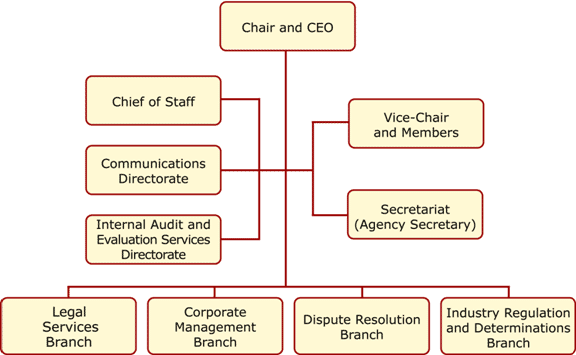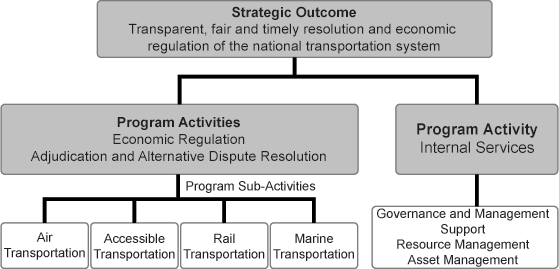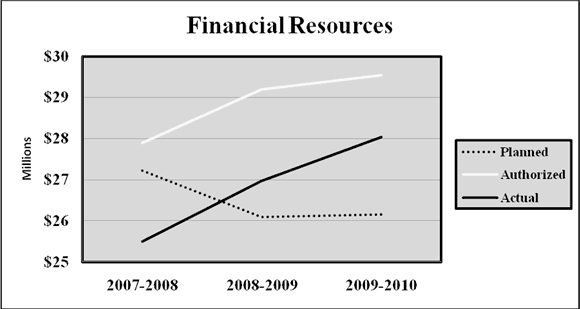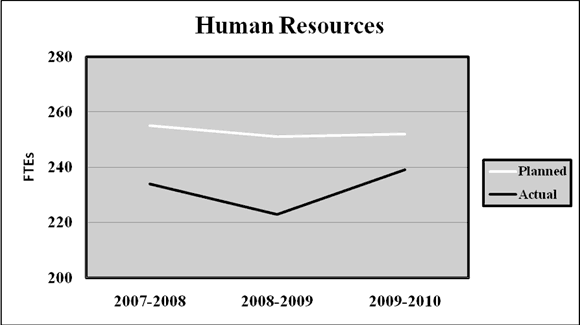Common menu bar links
Breadcrumb Trail
ARCHIVED - Canadian Transportation Agency - Report
 This page has been archived.
This page has been archived.
Archived Content
Information identified as archived on the Web is for reference, research or recordkeeping purposes. It has not been altered or updated after the date of archiving. Web pages that are archived on the Web are not subject to the Government of Canada Web Standards. As per the Communications Policy of the Government of Canada, you can request alternate formats on the "Contact Us" page.
Message from the Chair and Chief Executive Officer
The Canadian Transportation Agency's 2009–2010 Departmental Performance Report summarizes the measures taken by the organization to solidify its place as one of the country's leading tribunals through leadership, impartiality and consistency.
Major updates for a number of regulatory frameworks also got underway, such as for marine coasting trade, rail interswitching, and cost of capital methodology for railways — all of which will support the Agency's goal of providing transparent, fair and timely dispute resolution and economic regulation of the national transportation system.
The Agency also responded to a series of ministerial directives in respect of a Canada-United States dispute involving professional sports team air charters and accepted tariff filings to reflect commitments made by air carriers as part of the Government of Canada's “Flight Rights” initiative.
As part of its mandate to make transportation accessible to all, the Agency became one of the first Government of Canada organizations to make publications available for download in DAISY format — a digital “talking book” that makes content accessible to persons who are blind or have a visual impairment. It also released new guidelines to assist air carriers in implementing provisions of the Code of Practice: Aircraft Accessibility for Persons with Disabilities.
On a broader level, the Agency sought feedback from transportation service providers and users through a new client satisfaction survey program. Preliminary results available at this stage validated the key corporate priorities of the Agency's three-year Strategic Plan adopted in 2008, and the many actions that have been taken to implement the Plan.
The Agency continued to face workload challenges this year as a result of increased responsibilities, more complex cases, and staff retirements. The organization nonetheless remained proactive in addressing these and other issues by quickly adapting its internal processes to ensure resources were appropriately deployed.
By working closely with its clients and stakeholders and other government departments, the Agency supports the goal of achieving a national transportation system that is competitive, efficient and accessible to all.
Finally, recent and upcoming Agency initiatives point to a future that will see further improvements to the Agency's service levels and standards, an evolution which is fully consistent with government-wide objectives on efficiency and responsiveness.
Geoffrey C. Hare
Chair and Chief Executive Office
Section I: Overview
Raison d'être
The Canadian Transportation Agency is an independent administrative body of the Government of Canada. It performs two key functions within the national transportation system:
- as a quasi-judicial tribunal, the Agency, informally and through formal adjudication, resolves a range of commercial and consumer transportation-related disputes, including accessibility issues for persons with disabilities. It operates like a court when adjudicating disputes; and
- as an economic regulator, the Agency makes determinations and issues authorities, licences and permits to transportation carriers under federal jurisdiction.
Our Mandate
To administer the economic regulatory provisions of Acts of Parliament affecting all modes of transport under federal jurisdiction.
Our Mission
To assist in achieving a competitive, efficient and accessible transportation system through dispute resolution, essential economic regulation and communication in a fair, transparent and timely manner.
Our Vision
To be a respected, leading tribunal contributing to a competitive and accessible national transportation system efficiently meeting the needs of users and service providers and the Canadian economy.
Visit our Web site for more on the Agency's role and vision1.
Responsibilities
By administering transportation regulations and providing dispute resolution services, the Agency ensures that transportation users, commercial shippers and individual travellers receive the protection provided for them in the legislation where market forces alone do not result in fair, reasonable service, and ensures that carriers meet basic public policy requirements before engaging in transportation activities. In doing so, the Agency continually sets and strives to achieve high performance standards.
Education and consultation are integral to the Agency's effectiveness in carrying out its mandate. The Agency works closely with transportation service users and providers in Canada and with other stakeholders directly affected. It helps travellers, shippers, carriers, municipalities and others to fully understand not only their rights and obligations under the Canada Transportation Act, but also the Agency's roles and responsibilities.
When appropriate, the Agency encourages parties to resolve disputes informally before issues escalate and impact the transportation system. The Agency consults broadly on issues that are important to the transportation industry. By remaining open and by listening to all affected parties, the Agency ensures that its decisions are both responsive and responsible.
The Agency exercises its powers through its Members who are appointed by the Governor in Council (GIC): the GIC may appoint up to five full-time Members, including the Chair and Chief Executive Officer (CEO), and the Vice-Chair. The Minister of Transport, Infrastructure and Communities can also appoint up to three temporary Members.
The Chair and CEO is accountable for the Agency's three program activities. The Vice-Chair replaces the Chair and CEO during his absence. All Agency Members are accountable for making quasi-judicial decisions on matters before the Agency.
Agency Organization Chart
The Agency's organizational structure is composed of four branches: the Dispute Resolution Branch, the Industry Regulation and Determinations Branch, the Legal Services Branch and the Corporate Management Branch. The heads of each branch, as well as the Communications Directorate, the Internal Audit and Evaluation Services Directorate, and the Secretariat Directorate, report directly to the Chair. The Agency implemented this new organizational structure in 2008–2009 to integrate a modal approach (air, accessible, rail and marine) within a functional business delivery model to allow the Agency the flexibility to effectively deal with evolving workload and resource challenges while still meeting client-driven demands. This structure also creates greater opportunities for learning and professional development, more variety in work assignments and internal mobility for employees between directorates and branches.
The Agency's headquarters are located in the National Capital Region. Agency personnel working in field offices in six cities across Canada carry out air and accessibility enforcement activities. The Agency's role and structure2 are described on its Web site.
Parliament funds the Agency through an operating expenditures vote. The Agency operates within the context of the very large and complex Canadian transportation system3.
Strategic Outcome and Program Activity Architecture (PAA)
PAA Crosswalk
As approved by the Treasury Board, the Agency modified its PAA for 2009–2010 with the following change to its program activities:
| 2008–2009 | 2009–2010 |
|---|---|
|
|
The sole program activity was divided into three program activities following changes to the Agency's organizational structure. The Agency regulates the national transportation system (air, rail and marine) through the administration of laws, regulations, voluntary codes of practice, education and outreach programs, and adjudicates disputes between users of, service providers within and others affected by the national transportation system. With this clear distinction between activities, the expected results, performance measures and resource requirements are more closely linked to how the Agency delivers its mandate.
Summary of Performance
Financial and Human Resources Information
The resources used in relation to the Strategic Outcome in fiscal year 2009–2010 are summarized in the following tables.
| Planned Spending | Total Authorities | Actual Spending |
|---|---|---|
| 26,152 | 29,544 | 28,041 |
| Planned | Actual | Difference |
|---|---|---|
| 252 | 239 | -13 |
| Performance Indicator | Targets | 2009–2010 Performance |
|---|---|---|
| Feedback from users of, service providers within, and others affected by the national transportation system on perceived transparency, fairness, and efficiency of the decision-making process. | Conduct benchmark surveys and set targets. | Met performance target. Conducted survey and collected preliminary data. Benchmarks will be determined upon analysis in fall 2010. |
| Conduct subsequent survey. | Continued and broadened surveying is scheduled for 2010–2011. | |
| Percentage of discretionary rulings overturned by the Federal Court of Appeal on basis of procedural fairness. | 0% | Met performance target. |
| Percentage of cases resolved within prescribed time limits. | Disputes resolved formally: 65% resolved within 120 days. | 43%[i]. Did not meet performance target. |
| Determinations: 95% issued within 120 days. | 97%. Exceeded performance target. | |
| Licences: 85% issued within 14 days. | 90%. Exceeded performance target. | |
| Charter permits: 92% issued within 30 days. | 91%. Mostly met performance target. | |
| Mediation: 100% completed within 30 days (when no extension is requested). | 100%. Met performance target. |
| Program Activity[ii] | 2008–2009 Actual Spending | 2009–2010[iii] | Alignment to Government of Canada Outcomes | |||
|---|---|---|---|---|---|---|
| Main Estimates | Planned Spending | Total Authorities | Actual Spending | |||
|
Economic Regulation |
10,304 | 11,902 | 11,902 | 13,324 | 12,324 |
A fair and secure marketplace |
|
Adjudication and Alternative Dispute Resolution |
6,766 | 6,584 | 6,584 | 7,477 | 7,261 | |
|
Internal Services |
9,915 | 7,666 | 7,666 | 8,743 | 8,456 | |
|
Total |
26,985 | 26,152 | 26,152 | 29,544 | 28,041 | |
Explanation of variances
Planned spending to total authorities: from $26.1 million to $29.5 million
Planned spending for 2009–2010 was $26.1 million, whereas the total authorities for the Agency are $29.5 million, representing a change of $3.4 million. The differences are primarily due to the following increases:
- approved collective agreements and other associated benefits ($1.4 million);
- reimbursement of eligible paylist expenditures ($0.9 million); and
- operating budget carry-forward of 2008–2009 ($1.1 million).
Actual spending to total authorities: from $28.0 million to $29.5 million
The difference of $1.5 million is mainly for the following reasons:
- $1.1 million in operating expenditures that are deferred and carried forward to 2010–2011;
- $0.2 million received from the collective agreement of excluded members from the Law (LA) group that is eligible to be carried forward and that will be distributed during the 2010–2011 Supplementary Estimates (B); and
- $0.2 million in general lapses due to delays in contracts and the reassessment of certain projects.
Contribution of Priorities to Strategic Outcome
| Priority | Type | Performance Status | Link to Strategic Outcome |
|---|---|---|---|
|
Effective dispute resolution and economic regulation |
Ongoing | Mostly met and ongoing | The Agency has a triennial strategic plan for 2008–2011 with an overarching objective to firmly establish the Agency as a leading tribunal of the Government of Canada. This is accomplished by focusing on these five priorities, which are directly linked to the Agency's strategic outcome of providing transparent, fair and timely dispute resolution and economic regulation of the national transportation system. |
|
Focusing on people as its greatest asset |
Ongoing | Mostly met and ongoing | |
|
Enhanced internal and external relations through clear and timely communications |
Ongoing | Mostly met and ongoing | |
|
Accessible transportation network without undue obstacles to the mobility of persons |
Ongoing | Mostly met and ongoing | |
|
Organizational support and responsiveness through superior management practices |
Ongoing | Mostly met and ongoing |
A summary of the Agency's key accomplishments for these priorities during 2009–2010 is as follows:
Effective dispute resolution and economic regulation
- Complied with ministerial directives related to a Canada-United States dispute involving professional sports team air charters, one of which called for an investigation into the carriage of passengers by U.S. carriers solely between Canadian cities;
- Supported the negotiation of important bilateral air transport treaties;
- Accepted tariff filings from Air Canada, Jazz, WestJet and Air Transat reflecting commitments made by these airlines as part of the Government of Canada's “Flight Rights” initiative;
- Encouraged Canadian air carriers to put their tariffs into plain language, helping Canadians make informed decisions about their travel arrangements;
- Made a determination stating that the rail link to Toronto's Lester B. Pearson International Airport proposed by the Union-Pearson AirLink Group is not under federal jurisdiction;
- Launched initiatives to update a number of regulatory frameworks administered by the Agency, on matters such as marine coasting trade, railway interswitching, and cost of capital methodology; and
- Announced that the revenues of the Canadian National Railway Company for the movement of Western grain had exceeded its revenue cap for crop year 2008–2009, while those of the Canadian Pacific Railway Company for the same period were below its cap.
The Agency's people as its greatest asset
- Mandated the creation of an employee-led working group (EWG) tasked with developing solutions to issues highlighted in the Public Service Employment Survey, engaged in an extensive consultation process with staff and management on sustaining a respectful workplace, and implemented concrete actions brought forward by the EWG to ensure that the Agency remains a workplace of choice;
- Continued to implement knowledge transfer projects, student recruitment initiatives and developmental opportunities for staff; and
- Developed new competency profiles and learning roadmaps for certain positions.
Enhanced internal and external relations
- Published a number of publications to assist Canadians in resolving transportation-related disputes, such as Rail Noise and Vibration Complaints: Working together towards solutions;
- Began implementing a client satisfaction survey framework and collecting benchmarking data on client satisfaction;
- Initiated a number of consultations with stakeholders and clients within the national transportation network in order to better serve Canadian consumers and transportation providers;
- Implemented a client-centred inquiry service delivery model to respond to inquiries from the general public. This integrated system allows for the tracking and analysis of inquiries and increased consistency of messaging;
- Began the complete overhaul of the Agency's intranet through an Intranet Working Group that reviewed the site's content and provided feedback. The old site was significantly streamlined in advance of the migration to the new intranet site, launched in May 2010; and
- Compiled an inventory of stakeholder outreach activities taking place within the Agency and presented recommendations to the Executive Committee, which were adopted.
A more accessible transportation network
- Released guides to assist air carriers in implementing provisions of the Code of Practice: Aircraft Accessibility for Persons with Disabilities related to space for service dogs and tactile row markers;
- Made significant progress in resolving disputes related to the appropriate accommodation of air travellers disabled as a result of their allergies;
- Became one of the first federal government bodies to make publications available for download in DAISY format — a digital talking book that makes print publications accessible to persons who are blind or have a visual impairment; and
- Launched innovative accessible electronic formats of Take Charge of Your Travel, a popular Agency publication that helps persons with disabilities plan their trips from start to finish.
Organizational support and responsiveness
- Addressed a number of dispute case processing issues and implemented process improvements and new practices that promote increased productivity, efficiency and consistent quality; and
- Adopted a revised Case Management Policy that will support better tracking of the progress of case files, increasing work efficiency and promoting best practices.
Link to the Government of Canada Outcome Areas
The Agency's strategic outcome and program activities are directly aligned with the broader Government of Canada strategic outcome of a fair and secure marketplace. The Agency's regulatory programs are designed to resolve economic issues, remove transportation barriers and protect the rights of consumers, carriers and other interested parties. These programs help improve the overall quality of life in Canada, providing all Canadians with an efficient and accessible transportation system.
The Agency is one of many players involved in transportation and it maintains close ties with its various co-delivery partners4, including Transport Canada, the Department of Foreign Affairs and International Trade, the Canada Border Services Agency and the Canadian Human Rights Commission.
Risk Analysis
The Agency has established itself as a respected and valued economic regulator and expert tribunal for transportation and human rights issues by maintaining its independence from outside influence, by the impartiality it has demonstrated in handling cases, the integrity and timeliness of its procedure, its expertise in transportation and transportation-related human rights matters, and the deference that the Federal Court of Appeal and the Supreme Court of Canada have shown the Agency regarding its decisions. The Agency has also been sensitive to its clients by adapting its processes to their needs and being responsive to changing environments. To maintain this reputation, the Agency must continue to be attentive to all of these aspects of its role as an economic regulator and quasi-judicial administrative tribunal.
The Agency continued to integrate risk management into its strategic planning process and encouraged effective risk management in 2009–2010. Course corrections were made based on risk management performance and new information. The Legal Services Branch put in place a Legal Risk Management Framework and the Agency is part of the Interdepartmental Advisory Committee on Legal Risk Management.
The Agency remains proactive in monitoring and addressing any changes in resource requirements. This is accomplished through dialogue with stakeholders (clients, federal government partners, Parliamentarians, the Minister of Transport and special interests groups), which allows the Agency the opportunity to address and adapt internally, and to ensure it has sufficient resources (financial and human) that are properly deployed.
As identified in its Report on Plans and Priorities, the Agency continued to face fundamental workload challenges as a result of increased responsibilities, more complex cases, limited budget and employee retirements. A working group created as a result of the new organizational structure continued its work addressing case processing challenges and finding effective ways to deal with them. The working group developed a series of tools to improve efficiency and consistency in the management of formal cases and is promoting training to assist staff in using these tools.
The complexity of cases treated by the Alternative Dispute Resolution (ADR) Directorate also increased. Given that the number and complexity of ADR cases is not predictable since it is client driven, this creates a possible resources challenge for the Directorate. To mitigate this risk, the Agency has a roster of mediators that would address potential increases in demand beyond the capacity of the ADR Directorate.
The retention of knowledge and expertise is critical to maintain the level of service already provided, as well as to adapt to additional responsibilities. The changing demographics of the Public Service workforce and of the Agency in particular present a significant human resource management challenge. The Agency is at risk of losing corporate knowledge and expertise over the next few years as long-term key employees with knowledge and experience unique to the Agency face retirement. The Agency has made significant strides through initiatives that support recruiting, retaining and developing highly competent staff with the capabilities to ensure there is a transfer of knowledge and expertise to continue supporting the Agency's mandate.
The Agency maintained its education and consultation processes, which are integral to the Agency effectively dealing with the challenges of a changing environment and allowing it to be more responsive to Canadians and national economic objectives.
Expenditure Profile
When a new organizational structure was implemented on April 1, 2008, the Agency's staff vacancy rate was at 20% due to pending staffing processes and a high retirement rate. Management and human resources staff made a concerted effort to fill vacant positions through external and collective processes, and on March 31, 2010, the vacancy rate was at 7%, closing the gap on a target of 5%. Through effective human resources planning, the Agency will continue to run collective staffing processes to develop pools of qualified candidates for upcoming vacancies.
Voted and Statutory Items
| Vote # or Statutory Item (S) | Truncated Vote or Statutory Wording | 2007–2008 Actual Spending | 2008–2009 Actual Spending | 2009–2010 Main Estimates | 2009–2010 Actual Spending |
|---|---|---|---|---|---|
|
Canadian Transportation Agency |
|||||
| 25 |
Operating expenditures |
22,423 | 23,919 | 22,933 | 24,626 |
| (S) |
Spending of proceeds from the disposal of surplus Crown assets |
0 | 17 | 0 | 0 |
| (S) |
Contributions to employee benefit plans |
3,069 | 3,049 | 3,219 | 3,415 |
| Total | 25,492 | 26,985 | 26,152 | 28,041 | |
[i] Includes a number of cases involving complaints by air travellers with disabilities related to allergies for which the processing time was prolonged due to the need for expert research and opinions.
[ii] Numbers for each program activity include contributions to employee benefit plans.
[iii] Commencing in the 2009–2010 Estimates cycle, the resources for the Internal Services program activity are displayed separately from other program activities; they are no longer distributed among the remaining program activities, as was the case in previous Main Estimates. This has affected the comparability of spending and FTE information by program activity between fiscal years.




